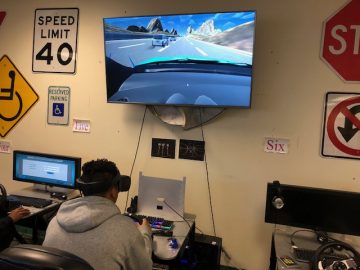High School trains novice drivers with virtual reality driver’s education program
 Driver Education Teachers Justin Hager and Dana Sacony at Hatboro-Horsham High School wanted students to have a more realistic driver-training experience than a regular simulator on a computer screen. After they discovered that companies like FedEx and UPS train their delivery drivers with virtual reality (VR) software, Hager and Sacony wanted to see if they could train their student drivers that way too.
Driver Education Teachers Justin Hager and Dana Sacony at Hatboro-Horsham High School wanted students to have a more realistic driver-training experience than a regular simulator on a computer screen. After they discovered that companies like FedEx and UPS train their delivery drivers with virtual reality (VR) software, Hager and Sacony wanted to see if they could train their student drivers that way too.
“That’s when the ball really got rolling and we started more research on the topic,” said Hager, who wrote The Use of Virtual Reality in the Driver’s Education Classroom grant with Sacony. Hatboro-Horsham Educational Foundation awarded them a 2019-2020 Innovative Learning Grant for $5,839 to fund the initiative.
The final version of the software arrived to the high school in February and there has been a lot of positive feedback from the students. Students have an Oculus headset and googles to fully immerse them in driving, a steering wheel and pedals.
“Students like that they have a 360 view instead of just one screen to look at,” said Sacony. “The program is catching their attention and students are really excited so far.”
The VR software is designed to closely mimic the driver’s exam. The three modules feature highway driving, city driving, and the final unit includes crossing railroad tracks and parallel parking. Often, when students fail their drivers’ tests, it is due to parallel parking and this program allows them to practice that and park between two cones.
“Driving is a lot more realistic in virtual reality than the simulator,” said Hager. “The turns are sharper because they are now getting the response from the steering wheel that they would experience in a real car.”
While a student is using the program, the rest of the class can see what that student sees in their VR goggles on the TV. To further prepare them for their drivers’ tests, Hager and Sacony plan to break the students into groups and give them checklists to help critique their classmate’s driving skills like a test instructor would do.
The high school’s driver education course is an elective taken by tenth, eleventh and twelfth grade students.

